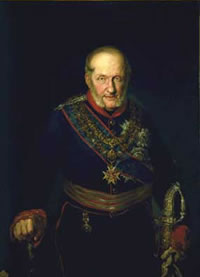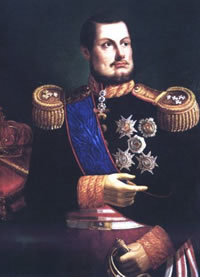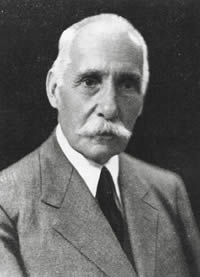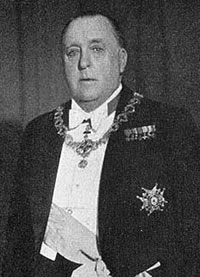History of the House of Bourbon - Two Sicilies
The Norman nobleman Tancred of Hauteville settled in Sicily ca 1020, and was father with other sons of (1) William (died 1046), who became Count of Apulia ca 1040, (2) Robert (died 1085), who took the title Duke of Apulia (and was father of the great crusader leader Bohemond, Prince of Taranto and Antioch, who died in 1100, and of Roger, Duke of Apulia, who died in 1109), and (3) Roger (died in 1101), invested as Count of Sicily by the Pope. The latter was father of Roger II (d 1154), whose assumption of the title King of Sicily was recognized by the Pope as suzerain in 1130.
Charles of Bourbon and Farnese, Duke of Parma Ferdinand IV of Naples and III of Sicily
(later Carlo VII of Naples and Carlos III of Spain) (later Ferdinand I of the Two Sicilies)
Roger s direct male line became extinct in 1198 when the Sicilian Crown passed through Roger II s daughter Constance to the Emperor Frederick II (of Hohenstaufen), who died in 1250. With the death of Frederick s son Conrad IV, in 1254, the Crown of Sicily fell into dispute for centuries, first between the natural son of Frederick, Count Manfred, and Charles of France, Duke of Anjou on whom the Pope invested the Crown in 1265 to prevent the continuation of Hohenstaufen rule, and after the death of Manfred between the duke of Anjou and Conrad IV s son, Conradin, and then Pedro of Aragon (elected King 1282), who had married Manfred s daughter Constance. The House of Aragon continued to rule in Sicily until 1516, when Sicily passed with the Crown of Aragon to the Habsburg Kings of Spain. Meanwhile the claim to Sicily was continued by the Duke of Anjou who had been crowned by the Pope Kings of Naples. When the Anjou heir lost the throne of Naples to Alfonso V, King of Aragon, in 1435, he was able to united both claims to the throne of Sicily, taking the historic title of King of the Two Sicilies (Rex Utriusque Siciliae).


Francis I, King of the Two Sicilies Ferdinand II, King of the Two Sicilies
On Alfonso V s death in 1458 he divided the thrones once again, leaving Sicily and Aragon to his brother John II (died in 1479), father of Ferdinand, King of Aragon (died 1516), and Naples to his natural son Ferdinand (died 1491) whose line became extinct in 1504 when the Neapolitan Crown reverted to Aragon and thus became part of the vast and expanding Spanish Empire. The Kingdom of the Two Sicilies was ruled by Viceroys appointed by Spain until 1713, and then Austria (following the Treaty of Utrecht of 1713, although Sicily was ruled separately by the House of Savoy from 1713-18). Austrian ruled ended with the Spanish victory of Bitonto in 1734, which led to the accession to the two thrones of the Infant Charles of Spain (later Charles III of Spain), elder son of the marriage of Philip V, King of Spain (grandson of Louis XIV) to his 2nd wife, Isabella Farnese, heiress of the duchy of Parma.
Francis II, King of the Two Sicilies H.R.H. Don Alfonso, Count of Caserta
The present line was founded by Infant Ferdinand of Spain (b 12 Jan 1751; d 4 Jan 1825), to whom his father, King Charles III of Spain, had abdicated as King of Naples and Sicily on 6 Oct 1759, in the Pragmatic Decree which required that the Crowns of Spain and the Italian Sovereignties and Estates not be united in the same person. This act gave reciprocal rights to both thrones to all the male descendants of Charles III, requiring that on the extinction of the male line the Two Sicilies throne would pass to the female most closely related to the last King (or Head of the House). This decree was confirmed by Art 5, Law of 8 Dec 1816, the Sovereign Acts of 7 Apr 1829 and 12 Mar 1836, and Chapter IV, Art 70 of the Constitution of 10 Jan 1848, reinforced by Royal Proclamation 28 Jun 1860. By a separate decree 16 Oct 1759 the Grand Magistery of the Constantinian Order (an independent religious-military Order, sui generis and subject of canon law), along with the Farnese properties were passed to the new King Ferdinand as "legitimate primogeniture heir of the Farnese" (primogenito legittimo farnesiano). Ferdinand IV King of Naples and III, King of Sicily, retained the title Infant of Spain, and from 8 Dec 1816 reigned as King Ferdinand I of the Kingdom of the Two Sicilies.


H.R.H. Don Ferdinand Pius, Duke of Calabria H.R.H. Don Alfonso, Duke of Calabria,
Infante of Spain
By Art 165 (III), Constitution of 1820/21, the King "cannot alienate, cede, or renounce in any way to any other person the Royal Authority" and could only "abdicate the throne in favour of the person of his immediate successor" reinforced as an Act relating to the Royal Family by the 1848/60 Constitution. The prohibition against any renunciation of future successions is also enforced in the Civil Code of the Kingdom, allowing for a deviation from the primogeniture line only if the King of the Two Sicilies inherited the Spanish Crown or became Prince of the Asturias. The dynasty ceased to reign when the Kingdom of the Two Sicilies was annexed to the new Kingdom of Italy on 17 Dec 1860. King Francesco II (b 16 In 1836; d 27 Dec 1894; succ 22 May 1859) protested against the annexation 12 Dec 1860 and held the fortress of Gaeta until 13 Feb 1861, when he was obliged to surrender and leave for exile in Rome, then Bavaria.
H.R.H. Don Carlos H.R.H. Don Pedro
Succession is by male primogeniture in the descendants of Ferdinand I, then by male primogeniture among the younger sons of Charles III, then to the descendants of Charles IV and failing such male heirs to the female most closely related to the last King (or Head of the House). Marriages of members of the House are regulated by the Sovereign Acts of 7 Apr 1829 and 12 Mar 1836, requiring Princes and Princesses to have prior permission of the King to marry, failing which the marriage would be null and void for succession purposes. The sons and daughters, and grandsons and granddaughters in the male line of the King (or Head of the House) bear the title of Prince Royal or Princess Royal of the Two Sicilies with the qualification of Royal Highness, all other cadets born of dynastic marriages bear the title Prince or Princess of the Two Sicilies with the qualification of Royal Highness. These titles are customarily abbreviated to Prince or Princess of Bourbon-Two Sicilies.
